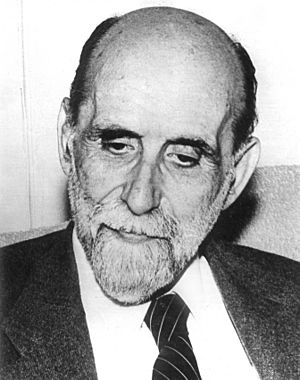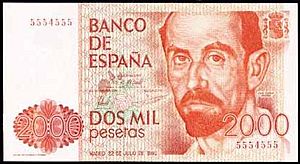Juan Ramón Jiménez facts for kids
Quick facts for kids
Juan Ramón Jiménez
|
|
|---|---|
 |
|
| Born | Juan Ramón Jiménez Mantecón 23 December 1881 Moguer, Huelva, Andalucia, Spain |
| Died | 29 May 1958 (aged 76) San Juan, Puerto Rico |
| Occupation | poet |
| Nationality | Spanish |
| Genre | poetry |
| Notable awards | Nobel Prize in Literature 1956 |
| Spouse | Zenobia Camprubí |
| Signature | |
Juan Ramón Jiménez Mantecón (born December 23, 1881 – died May 29, 1958) was a famous Spanish poet. He wrote many beautiful poems and received the 1956 Nobel Prize in Literature. He won this award for his "lyrical poetry," which showed a high spirit and artistic purity in the Spanish language. One of his most important ideas was "pure poetry," which focused on the beauty of words themselves.
Contents
The Life of Juan Ramón Jiménez
Juan Ramón Jiménez was born in Moguer, a town in Andalucia, Spain, on December 23, 1881. He went to school at a Jesuit institution called San Luis Gonzaga. Later, he started studying law and painting at the University of Seville. However, he soon realized his real talent was in writing.
He decided to focus on literature, inspired by other writers like Rubén Darío. At just 18 years old, in 1900, he published his first two books. Sadly, his father passed away that same year, which made him very sad. He spent some time in France and then in a special place in Madrid to feel better.
Juan Ramón Jiménez often wrote about music and colors in his poems. He also wrote a famous prose poem about a writer and his donkey, called Platero and I (1914). This book became very popular.
In 1916, he married Zenobia Camprubí in the United States. Zenobia was also a writer and poet. She became a very important partner and helper in his life and work.
Life in Exile and Teaching
When the Spanish Civil War began, Juan Ramón and Zenobia moved to Puerto Rico in 1936. He settled there permanently in 1946. He faced another period of sadness and was hospitalized for a while.
Later, he became a professor of Spanish Language and Literature at the University of Puerto Rico. His writing greatly influenced many Puerto Rican writers. The university even named a building and a writing program after him. He also taught at the University of Miami in Florida and the University of Maryland.
Nobel Prize and Later Years
In 1956, Juan Ramón Jiménez received the Nobel Prize in Literature. This was a huge honor for his amazing poetry. However, just two days later, his wife Zenobia passed away from cancer. He was heartbroken and never fully recovered from losing her.
Juan Ramón Jiménez died two years later, on May 29, 1958, in the same clinic where his wife had died. Both he and Zenobia are buried in his hometown of Moguer, Spain.
Even though he was mostly known for his poetry, his prose book Platero y yo ("Platero and I") was very popular. He also worked with his wife to translate a play called Riders to the Sea. He wrote a huge amount of poetry throughout his life. Some of his well-known works include Sonetos espirituales (Spiritual Sonnets) and Piedra y cielo (Stones and Sky).
Juan Ramón Jiménez and Zenobia Camprubí used a slightly different way of spelling Spanish words than the official RAE standard.
Places Named After Him
Several streets have been named after Juan Ramón Jiménez to honor him. You can find streets named after him in cities like Madrid and Valencia.
His Books and Poems
Here are some of the original editions of his published works:
- Ninfeas (Water Lilies), 1900-Madrid.
- Almas de violeta (Souls of Violet), 1900-Madrid.
- Rimas (Rhymes), 1902-Madrid.
- Arias tristes (Sad Arias), 1902
- Jardines lejanos (Distant Gardens), 1904
- Elejías puras (Pure Elegies), 1908
- Elejías intermedias (Intermediate Elegies), 1909
- Las hojas verdes (The Green Leaves), 1909
- Poemas mágicos y dolientes (Magic and Painful Poems), 1909
- Elejías lamentables (Sad Elegies), 1910
- Baladas de primavera (Ballads of Spring), 1910
- La soledad sonora (The Sonorous Loneliness), 1911
- Pastorales (Pastoral), 1911
- Melancolía (the sonorous loneliness), 1912
- Laberinto (Labyrinth), 1913
- Platero y yo (Platero and I) (reduced edition), 1914
- Estío (Summer), 1916
- Sonetos espirituales (Spiritual Sonnets), 1917
- Diario de un poeta recién casado (Diary of a Recently Married Poet), 1917
- Platero y yo (complete edition) (Platero and I), 1917
- Eternidades (Eternities), 1918
- Piedra y cielo (Stone and Sky), 1919
- Segunda antología poética (Second Poetic Anthology), 1922
- Poesía (Poetry), 1923
- Belleza (Beauty), 1923
- Canción (Song), 1935
- Voces de mi copla (Voices of my Verse), 1945
- La estación total (The Full Season), 1946
- Romances de Coral Gables (Romances from Coral Gables), 1948
- Animal de fondo (Animal from the Deep), 1949
- Una colina meridiana (A Shining Hill) , 1950 (1st edition in Spain: Huerga & Fierro editores, 2002).
- La frente pensativa (1911-1912) [four unpublished poems] (The Thoughtful Face), 2001.
- I Am Not I
Translations of His Works
- Books of Love: The Lost Poems of Juan Ramon Jimenez. Athens:Kinchafoonee Creek Press, 2022.
See also
 In Spanish: Juan Ramón Jiménez para niños
In Spanish: Juan Ramón Jiménez para niños
- Spanish poetry
- Modernismo
- Puerto Rican poetry
- Puerto Rican literature
- Sonnet


